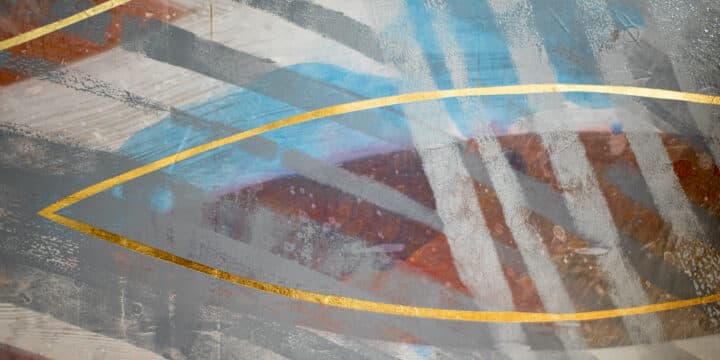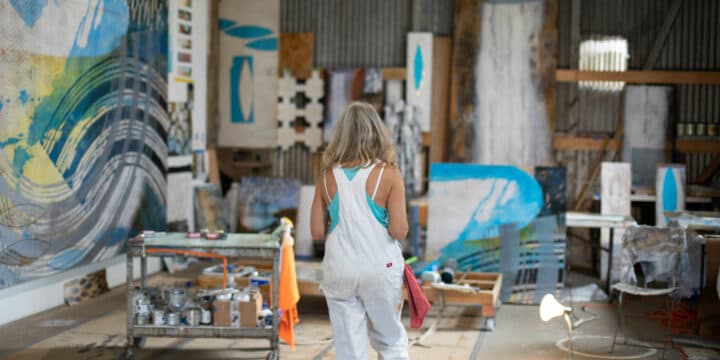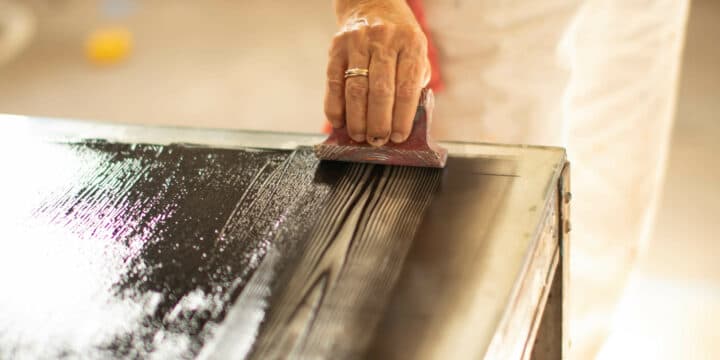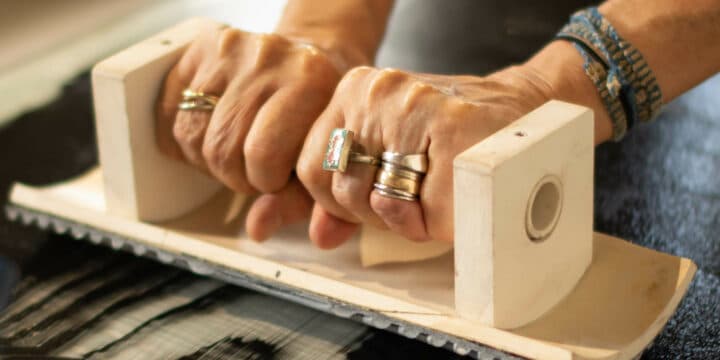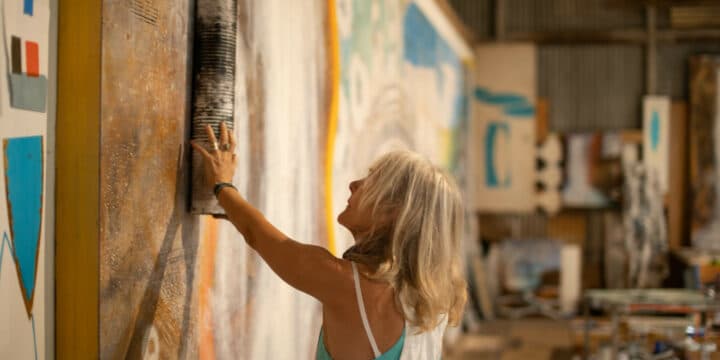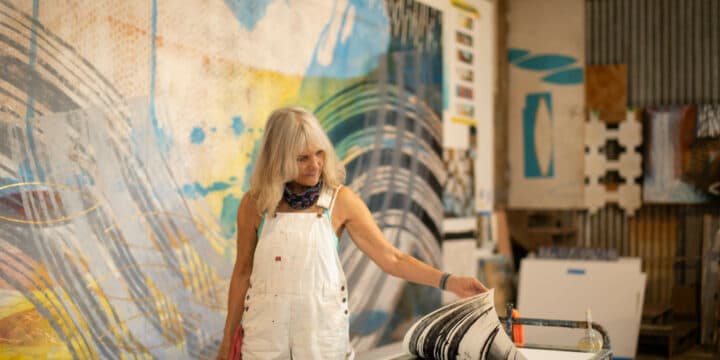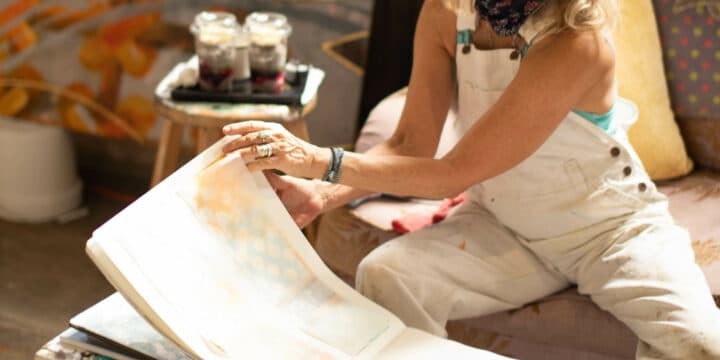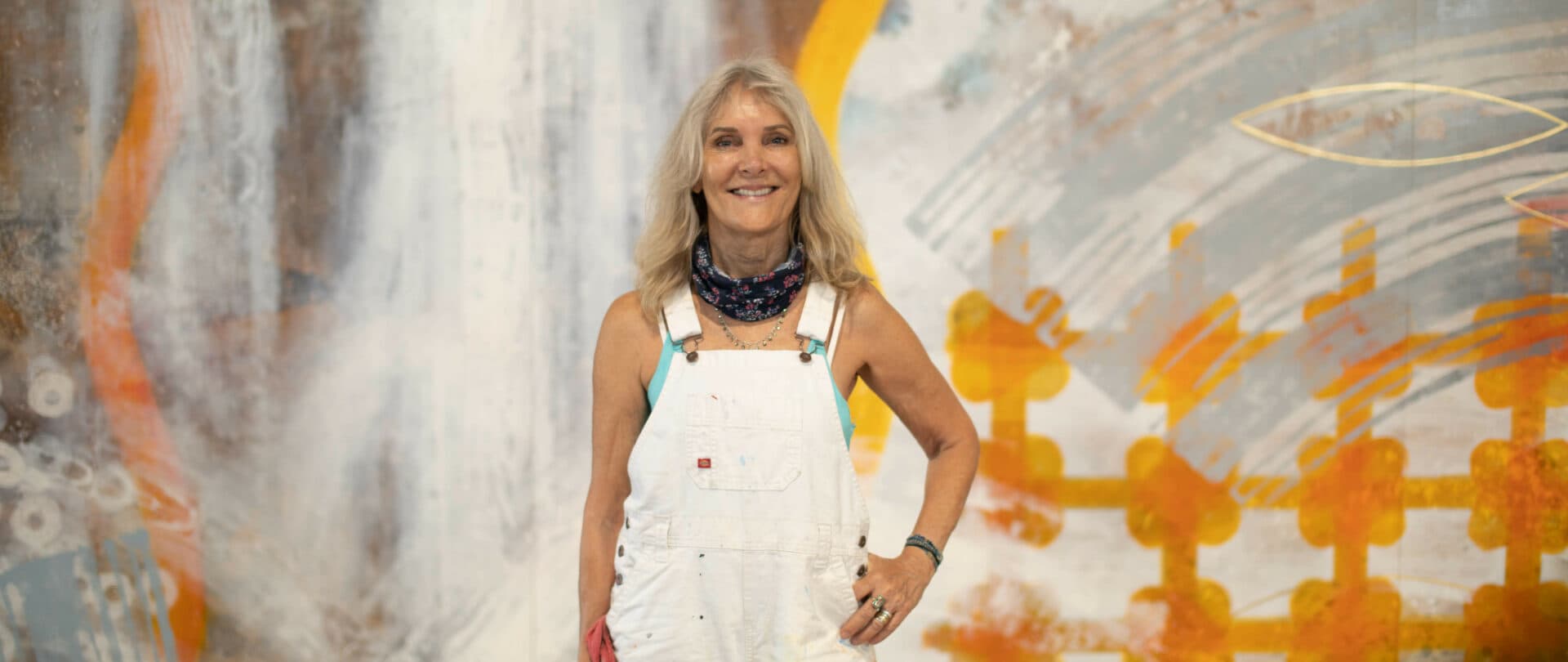
One Thing Leads to Another
Artist Carol Bennett
BY Mary Troy Johnston
Carol Bennett, artist extraordinaire, has a fascinating story. She also has a huge and amazing body of work that spans four decades. Speaking with her and studying her art, I am hard-pressed to find where the story ends, and the art begins.
Baby on hip, Carol as a young artist left her loft in Los Angeles to raise her child on Kaua‘i. She settles into a routine of swimming every day and painting swimmers. Periodically, she returned to Los Angeles where she continued her work on painting large scale billboards and backdrops for Disney and Universal. Her traveling “back and forth” was punctuated by solo shows, teaching and large commissions, with her first solo show at Stone’s Gallery on Kaua‘i when she was 28 years old. She now has what she describes as “a vibrant relationship” with Halale‘a Gallery on Kaua‘i and Tiffany’s Art Agency on the Big Island.
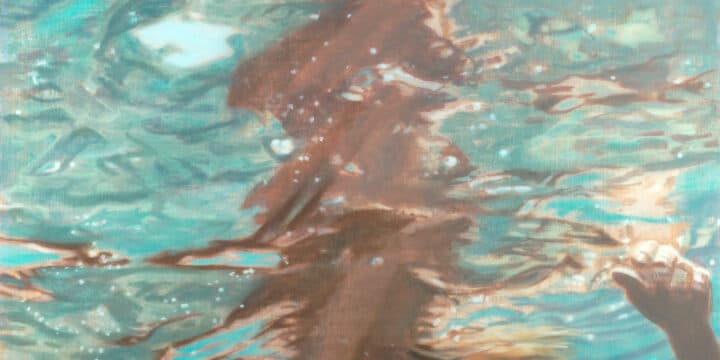
Her swimmers, strong and prominent in the water, reflected the independence of her early years as an artist. She was self-funded, raising her child and pursuing her career on her own. Her life and art became an intertwined constant. For 40 years, she has gotten into the water every day and painted swimmers. This is her “daily practice.” The enchanting spell of her swimmers is still very much alive. Carol describes how much her swimmers change. She describes how she is looking at four paintings of swimmers and how different each one is.
An art dealer recently purchased one from 2005 and said she bought it because “that painting is so fresh and vibrant.” Well, that swimmer painting is also like no other.
Throughout the series, the medium changes from repurposed materials, to wood, to used sail cloths, and she might just decide to paint one on a canvas to try something new. She sees herself when working with wood as “kissing her ground.” Attuned to “biomimicry,” the artist observes, “wood grain swirls like water.” Carol says that “changing up the materials keeps the swimmers fresh.” She sees her swimmers as “untethered by gravity.” The artist is the same, always in flow. She is moving, not pulled, along some invisible but intuited course, as unarticulated as it is intimate to the artist.
The way she describes her process, her body of work is “one thing leads to another.” That’s how Carol went from being a renowned painter with her work featured in museums, conducting solo exhibitions, and showcased in galleries to being a much in demand glass artist. She moved from large paintings to gargantuan public art commissions that occupy parts of buildings, form spectacular canopies and architectural sculptures. Her glass work is even more impressive when one learns she started in glass as a self-taught artist. The fascination began when Carol started making monoprints, so-called because the artist has only one chance to get it right, only one print to show for the effort. The technique involves painting a design on one side of glass intended to be viewed from the other side. According to Carol, “Both the printmaking process and reverse painting on glass ‘flip’ the image, so the final product is a backwards version of the painted image.” This “thing” led to “another.” She began to teach herself reverse painting on glass by studying Judy Jensen, an artist who is not only famous for reverse painting but for working other elements into the design to create a collage effect. Her first reverse painting commission turned out, in her opinion (which may not even do the painting justice), to be a ”killer piece.” Her glass mural entitled Fish Skins consists of five panels installed at Kings’ Land in Waikoloa on the Big Island. Her website describes it as a “bold graphic comprised of many layers.” Signature polka dots in various creative forms and color are incorporated with gold and silver leaf to evoke fish skins and eggs. She was thrilled that she “got to be experimental.” The inspiration from this work has carried her forward into a new exploration ever since.
Another, another, and another commission, so on and so forth, followed as the public art entities became convinced she was a glass artist. Her public art is on a different scale than her paintings since it occupies expansive public spaces such as metro rail stations, universities and judiciary buildings. Working with such grand proportions, she has had to travel to Glasmalarei Peters Studio in Paderborn, Germany to utilize one of the largest kilns in the world able to process 8.5’ W x 15’ L pieces, according to information from the studio. She has visited this studio to design and create the glass for three enormous projects, most recently, spending a month before Covid on a project that has been in her life for seven years. This will be installed at the Honolulu Airport in the near future.
Two of her glass commissions were installed in 2012: Cycles forms the tower-like section of the Joseph and Abigail Campbell Library at the University of Hawaii-West O‘ahu (UHWO) and Trigger Picasso Energy forms a canopy of glass-cum-photovoltaic solar cells and steel at the Hawaii State Art Museum Sculpture Garden. Despite the different settings of the glass projects, they both present a constant recreation of color, pattern and light, depending on the external environment. The glass tower at UHWO, which is three stories tall, has a deliberate rhythm of light progression. The artist had installed an astronomical clock to change the light conditions every quarter of an hour. Carol elaborates, Cycles’ astronomical clock is used for timing. It softly glows like a paper Japanese lantern, then bursts into a wildly animated light show perfectly timed on the quarter hour that lasts 15 seconds. She says of the time element, it “turned my beacon into a clock tower.” When I mentioned to Carol that I had seen reference to students using Cycles as a reference point to find their way across campus at night, she mentioned another story told to her by the provost. A student had informed him that she knew she was late to class when the glass tower changed colors. It must be a triumph for a public arts creator when people personally connect and adapt their habits to qualities of the piece.
Meanwhile, she continues to swim each day with the images she is destined to paint. For this article, the artist suggested four different paintings of swimmers to distinguish their differences. Indeed, beyond the subject of a female figure in the water, the tools used to create the images, colors, techniques, media and dimensions differ remarkably. Carol describes the figure in Cadillac as “painted with hand cut stencils and big gestural brushstrokes.” The surface is worked energetically with a variety of tools, “carved rollers” and a “faux wood grain dragging tool.” Wall Flower, a smaller painting, is politely subdued. When the light hits, “the figure illuminates itself and calls a great deal of attention to herself.” Unlike the contrasting colors in many of her paintings, this work has a dominant color of grey. Carol used an orbital sander to reveal the wood grain beneath the painting. A silhouette of a woman, her body weightlessly curving only as it can in water, is “rendered with pure silver leaf.” Another, Haena, drawn from “a bird’s-eye view” pictures a swimmer on her side in a pool of abstraction. The stunning water patterns are created by “numerous calligraphic marks used to describe the reflection and transparency of the water and its interaction with the swimmer.” And, Portal, takes us to one of her works consisting of mixed media on paper. She describes the piece as “having a soft glow to it.” The swimmer fronts an illusory “barrier” of teal blue stripes that to the artist are “fun” because “they are controlled evenly spaced drips.” Indicating her intimacy with her paintings, Carol remarks, “I love making works on paper as they are immediate and rooted as much in drawing.”
She is so connected to her swimmers that one must wonder: Where does Carol submerge, and where do the swimmers emerge? Or, are they the same in some metaphysical realm?
The scope of her work, the architectural glass projects, support the mastery this artist has achieved. Carol and the public are full of anticipation and excitement for her biggest project yet, to be installed at the Daniel K. Inouye International Airport in Honolulu.
To learn more about Carol's work, visit her at carolbennettart.com or on Instagram @cbennett002.
